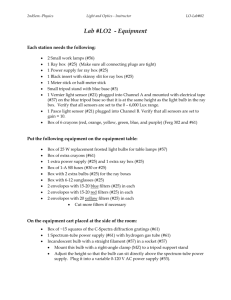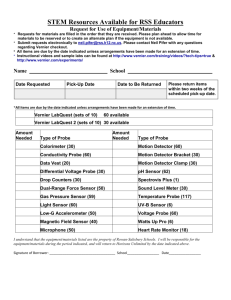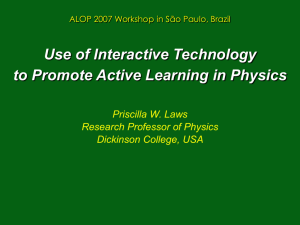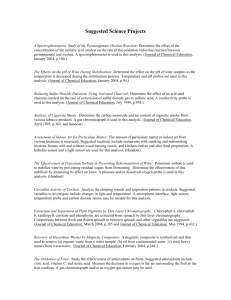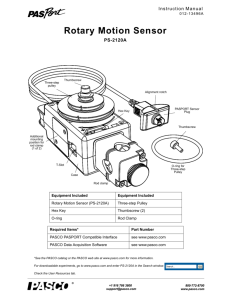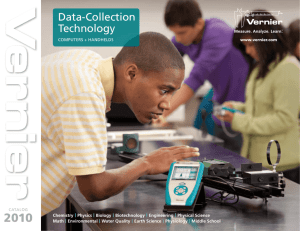Class Agenda - Office for Mathematics, Science, and Technology
advertisement
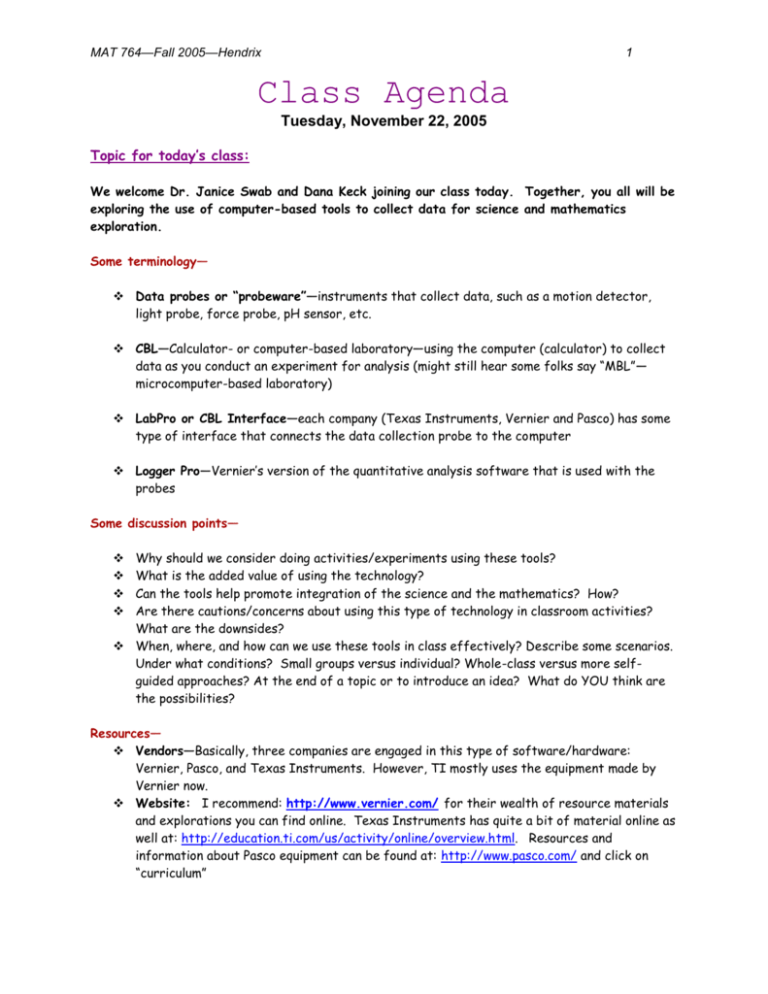
MAT 764—Fall 2005—Hendrix 1 Class Agenda Tuesday, November 22, 2005 Topic for today’s class: We welcome Dr. Janice Swab and Dana Keck joining our class today. Together, you all will be exploring the use of computer-based tools to collect data for science and mathematics exploration. Some terminology— Data probes or “probeware”—instruments that collect data, such as a motion detector, light probe, force probe, pH sensor, etc. CBL—Calculator- or computer-based laboratory—using the computer (calculator) to collect data as you conduct an experiment for analysis (might still hear some folks say “MBL”— microcomputer-based laboratory) LabPro or CBL Interface—each company (Texas Instruments, Vernier and Pasco) has some type of interface that connects the data collection probe to the computer Logger Pro—Vernier’s version of the quantitative analysis software that is used with the probes Some discussion points— Why should we consider doing activities/experiments using these tools? What is the added value of using the technology? Can the tools help promote integration of the science and the mathematics? How? Are there cautions/concerns about using this type of technology in classroom activities? What are the downsides? When, where, and how can we use these tools in class effectively? Describe some scenarios. Under what conditions? Small groups versus individual? Whole-class versus more selfguided approaches? At the end of a topic or to introduce an idea? What do YOU think are the possibilities? Resources— Vendors—Basically, three companies are engaged in this type of software/hardware: Vernier, Pasco, and Texas Instruments. However, TI mostly uses the equipment made by Vernier now. Website: I recommend: http://www.vernier.com/ for their wealth of resource materials and explorations you can find online. Texas Instruments has quite a bit of material online as well at: http://education.ti.com/us/activity/online/overview.html. Resources and information about Pasco equipment can be found at: http://www.pasco.com/ and click on “curriculum” MAT 764—Fall 2005—Hendrix 2 Assessment— How do you assess student learning and understanding during one of these activities? What about group dynamics and individual accountability? What do students do to complete your activity? How do they communicate their understanding of the concepts you wanted the activity/experiment to address? Both formative and summative assessment are addressed in the questions above. Ideas for experiments—thanks to Jennifer Noel, Heather Allmond, Heidi Brown and Rachel French ACCELEROMETER: Roller coasters (Carowinds) % of people who accelerate vs. stop at yellow lights CONDUCTIVITY PROBE: Measure acidity of soft drinks DUAL-RANGE FORCE SENSOR: Roller coasters – force acting against you Girl vs. Boy punches EKG SENSOR: Healthy heart vs. Sick heart Resting heart vs. Exercising heart EXERCISE HEART RATE MONITOR: Go to the gym & graph heart rate while on different machines Maybe look at differences between smoker & non-smoker FORCE PLATE: Run experiment similar to DASL measuring stability (different distractions, different ages…) Measure how the normal force changes while riding in an elevator LIGHT SENSOR: Test different sunglasses…do they block what they say they block? Testing Car tint VERNIER PHOTOGATE: PH SENSOR: Test different bodies of water (maybe see if the PH changes before and after rain) MAT 764—Fall 2005—Hendrix Test different rain samples RELATIVE HUMIDITY SENSOR: Measure humidity when weather is changing (cold/warm fronts) Inside versus outside Monitor daily indefinitely Humidity in different buildings (not just on campus…classroom, gym, mall…) RESPIRATION MONITOR BELT w/ GAS PRESSURE SENSOR: Measure human respiration in exercise (smoker vs. nonsmoker) Measure respiration in musicians ROTARY MOTION SENSOR: Merry-go-round Other rides to compare to basic circle (Scrambler, double ferris wheel) SOUND LEVEL MONITOR: Mall Roller coasters compare sound to force & acceleration STAINLESS STEEL TEMP PROB: Measure different temperatures in the different classrooms and buildings on campus (they say it is on a central controller…don’t forget to include variables such as # of people in the rooms) Inside a car (do the things you put in the windshield cool off the car?) UVB SENSOR: What time of day do you get the most UVB rays? Do temperate correlate with the amount of UVB rays? Cloudy vs. sunny? Sunscreen? (Would you put the sunscreen on the probe?) Clothing? DISSOLVED OXYGEN SENSOR: Does amount of dissolved oxygen differ in ponds with or without pond scum? # of fish vs. oxygen levels Assignments for this week: Metalesson— Readings: Finish your reading of Chapters 6 – 9 in Brahier (I know it’s a lot!) Assignments: Work on your unit plan!!! 3 MAT 764—Fall 2005—Hendrix 4 Unit Plan Project Your final project in this class is to create a unit plan. This project should be considered the culmination of your semester’s work in this class. The unit should be for more than one week of instruction and no more than 3 weeks of instruction. You will decide both the content and the grade level. You will present your unit during the finals week. You may give a short introduction to the unit overall, and then present one lesson. Typically, students prefer to present their introductory “hook” lesson to the unit, but you may present any one lesson. Components of the unit plan should include the following requirements. The entire unit should be contained online. The unit should have a front page, and both a teacher component and a student component. The front page should describe the unit and capture the reader’s interest. There should be an overview of the unit that includes both a calendar and a concept map. Rationale—provide a rationale for the unit. You should make reference to at least one research/professional article on the teaching and/or learning of that topic or at that level. Why do students need to understand this mathematics? Why is it appropriate for this course and/or grade level? Why is it appropriate where you have situated the unit in the curriculum. “Because it is in the same place in the textbook” is not a justification. How does this unit connect to the NCTM PSSM and to the NCSCOS? What special features are included in the unit and why are they valuable learning experiences? Describe your unit. References—You should cite at least one research-based article or book that supports your rationale. You should cite at least one non-textbook print resource that helped you prepare lessons for the unit and at least one online resource that helped you prepare lessons for the unit. You should cite any textbooks that served as a reference or guide. In the teacher component, there should be complete lesson plans with directions/guides/tips for a teacher to teach the lessons: grade level, content area, where it would fit in the curriculum, instructional tips, connections and references to appropriate standards (both NCTM and NCSCOS). Cite any appropriate references for ideas, activities, actual problems or activity sheets, etc. In the student component, there should be any and all activity sheets. The student could go to the website and follow the unit—maybe there are connections to online resources or activities; maybe there are directions to follow; maybe the worksheet is online; etc. Make it interesting. The lesson plans should make accommodations for diverse learning styles and learners with special needs. In the unit, there should be activities that address those who are kinesthetic learners, auditory learners, and visual learners. MAT 764—Fall 2005—Hendrix 5 The unit should include an introductory lesson to the unit and a concluding lesson to the unit. The introductory lesson in the unit should be a HOOK that captures the student’s interest into the unit, setting the stage for the study of the mathematics in the unit. One activity in the unit should be hands-on, using manipulatives of some sort. One activity in the unit should employ emergent technology—calculator, computer software, LabPro/Motion Detector, Internet, etc. One activity in the unit should make connections to real-world phenomena or to other disciplines of study (science, music, etc.) Assessment should be highlighted throughout the unit. In each lesson plan, there should be some form of formative assessment—whether informal or formal. There should be some form of summative assessment for the unit—project, concluding activity, journal, quiz, etc. At least one form of alternative assessment must be included in the unit. Consider this project to be your magnum opus for the course. It should demonstrate the synthesis of your understanding about teaching and learning mathematics to date. It should be a product of which you are proud to display in your portfolio. More importantly, it should be a product that you will be eager to use in the classroom in the future.
